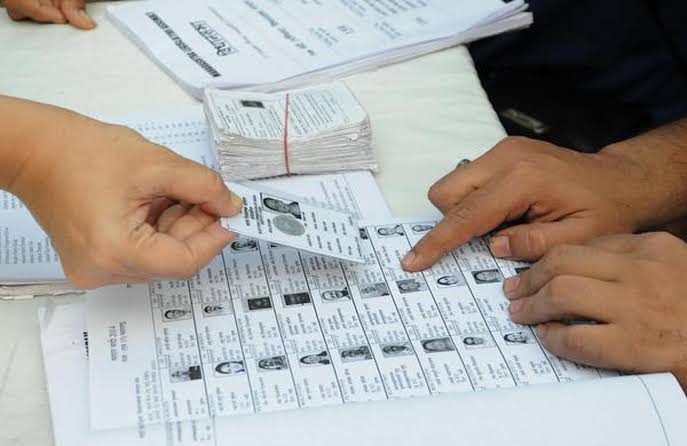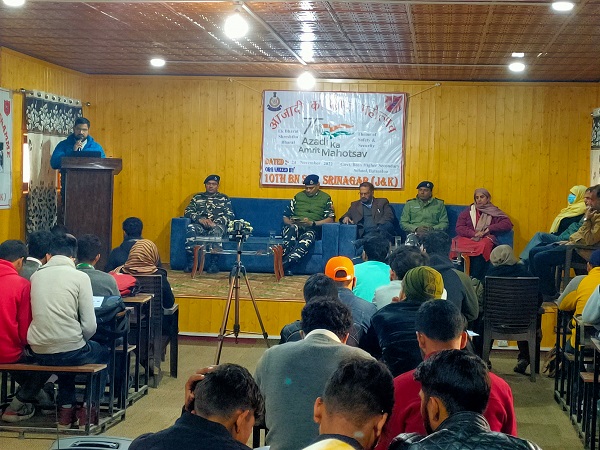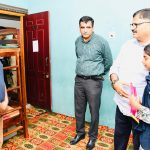NAZIR AHMAD GANAI / PARVAZE A SOFI
India towards knowledge superpower
India is now recognised as a key player in global geopolitical engagements. India’s rise as a strong nation has been a result of a strong political dispensation aiming to steer the country of 1.4 billion people into the league of elite nations, driven by the ethos of Unity in Diversity and strong national commitment to rise as a Vishwa Guru. As a nation with one of the largest young populations (~28%) and a country tipped to be the youngest population by 2030, India is contemplating empowering them as skilled and knowledgeable changemakers. Globally the demand for higher education is expected to grow exponentially from 100 million students currently to more than 250 million by 2025. This growth will be particularly driven by countries like India. Much of India’s progress in recent years has been driven by outstanding human resource output in and outside the country. India’s performance in key sectors such as agriculture, health, IT, space, manufacturing and service sector has been commendable, helping it become the World’s 3rd Largest Economy. Despite improving its performance across all indicators by 15.74% between 2010-2018, India still lags in Global Youth Development Index at 133rd rank, disproportionate to its techno-political standing in the world, attributed to the disproportionate flexibility and autonomy in multiple tiers of the education system.
India’s aspiration as Vishwa Guru India’s aspirations to be the Knowledge Superpower and a $10 trillion economy, lies in its Knowledge economydriven by eco-system of innovations. It demands a paradigm shift in our policy – improving of our ranking in spending on education from 144 to 50, and giving flexibility and autonomy to universities and colleges to innovate for the perceived Knowledge economy. |
During the last 20 years, India has remarkably transformed its higher education landscape through widespread access to low-cost, high-quality university education at all levels resulting in better enrolment numbers and enhanced learning outcomes. A strong and autonomous university system has enabled India to resolve the longstanding tension between excellence and equity. This, coupled with large-scale reforms, has given India a 70 million strong student population as a force to reckon with, comprising potential thought leaders, changemakers, researchers and academicians, and entrepreneurs positioned at the helm of knowledge creation, and driving the engine of its US$ 3 trillion economy.
Paradox of Development While India takes pride in having largest youth population, the largest educational system and is emerging as the fastest growing economy and the startup nation of the world, yet 133rd rank in Global Youth Development Index and fewer than 25 universities in top 200 universities, figures towards something really lacking. |
Why India needs to act
Despite these strides of progress, India’s higher education institutions are not yet the best in the world. Less than 25 universities figuring among the top 200 best institutions is paradoxical to the fact that India’s post-secondary education system is recognised as one of the best in the world. This bizarre disproportionation has led the national policy planning think tanks to reassess the country’s position vis-à-vis its future directions for education to act as a tool for national development. India’s policy dispensation has set ambitious targets for development indicators to march from a $ 5 trillion economy to $ 10 trillion by 2030, with much of India’s progress expected from knowledge-driven economic progress. India aims to be the Knowledge Superpower, and Shrestha Bharat, through a system of education that transforms today’s youth into tomorrow’s innovators, creators, nation builders, leaders and change makers. It is with this pursuit that India brought a new education policy (NEP-2020) 36 years after the last policy was enacted with an aim to help India to take a quantum lead in the next century through a highly competitive and flexible science education system that will be driven by innovation, discovery and knowledge and has a visible impact in discovery landscape of the world. Such systems, practised in the West, characterised by flexibility and autonomy in thought process, ideation and execution in all domains of their activity such as governance, recruitment, human resource management as well as perspective policy planning for developing short and long-term roadmaps encompassing all the hierarchies of the education system from K12 to the university system resulting in coherent progress at all levels. The policy aimed at creating a flexible education system that helps India create knowledge leaders, that can help the country solve the contemporary challenges and adapt and absorb new material in novel and changing fields, such as the rise of big data, machine learning, and artificial intelligence. The policy aims at creating a globally competitive system of education driven by innovation, discovery and technology development that will help India not only improve its human resource output but also capture the global technology and services market. The policy leverages substantial flexibility and autonomy to institutions encompassing K12 to university education to realign themselves to target.
NEP-2020: India’s resolve towards transformative education India enacted a new education policy in 2020 to remove the bottlenecks that have precluded India from harnessing the power of the largest youth population by infusing revolutionary ideas that favour greater flexibility and choice to students towards promoting access and equity as well as promoting institutional autonomy to bring innovative reforms. The policy aims at improving the skill sets, leadership attributes and poise next-gen students for propelling India towards an economic and intellectual power to reckon with. |
For the new system of education to deliver social and economic impact, as well as intellectual value it is imperative to have access, equity and qualityin the process of human capital development and accomplish the broader goals country has set for 2030 and beyond. There is a need for an education system that is transformative and innovative across all thelevers of higher education: from curricula and pedagogy to the use of technology to partnerships, governance, recruitment and funding. This is especially important in view of new drivers of action such as globalization, Intellectual property rights, new frontiers such as AI, ML, Big Data analysis, Biotechnology, nanotechnology, Sensors, Communication revolutions etc. Our new crop of educated youth needs to be skilled and empowered to handle new challenges posed by a globalized environment with a focus on national development.
Towards reformed agricultural education: ICAR vision and SKUAST-K initiatives
Agriculture is a key player in national development and is one of the resilient sectors of the economy as demonstrated during the Covid-19 pandemic. However, the sector faces many challenges such as (i) Below average productivity (to 60% of the worldaverage), (ii) Declining profitability (iii) rising competitiveness under globalisation, (iv) poor farm-to-marketlinkages, (v) Subsistence scale (vi) Huge research impact gaps, (vii) low level of mechanization andlack of value addition (viii) Sub-optimal Supply Chain Management, (ix) Greater challenges to sustainabilitydue to natural resources depletion, biotic andabiotic stresses. In order to create a competent human resource that can help the nation address new and emerging challenges and help sustain our leadership in key areas of agriculture, India needs to realign its agricultural higher education towards greater responsiveness and build a strong and resilient agriculture sector that not only helps India to fulfil its domestic food, nutrition and livelihood security commitments but also gain leadership position in these strategic sectors.
India has developed one of the finest models based on the land grant pattern ofthe USA with substantial autonomyforthe system to operate. India has one of the largest human resources in agriculture research and education in form of ICAR and its institutions as well as state agricultural universities that are catering to national as well as regional human resource and technology requirements of the country. With such a system, India has been able to give to this world some of the finest science leaders in agricultural research that have shaped modern research platforms across the globe. The system has helped India progress from just 50 million tonnes in 1950 to more than 300 million tonnes in 2022. A similar system has been allowed to flourish at state levels and SKUAST-K is the best demonstration of such an autonomous university research and education system that has helped the state in fulfilling its commitments to human resource development and improving food and nutritional security imperatives.
Well before NEP-2020, ICAR had envisioned a need to transform the Indian agricultural education system and heralded a holistic and far-reaching national initiative of NAHEP funded by the World Bank to realign the higher education in agriculture to global standards, leveraging greater freedom for reforms, innovative policy frameworks and sought to develop all the pillars including faculty, students, matching infrastructure as well as policy and governance freedom. SKUAST-K also earned the honour of being a proud partner in this national initiative through competitive pitching of its vision for a holistic education system that is led by innovation, discovery, technology developmentand entrepreneurship development by creating a learning environment that is inclusive, stimulating with a wide range of learning experiences and supported by most modern physical infrastructure and human resource, with a freedom to access, assess, adapt and apply knowledge to think independently so as to develop a sense of appropriate judgement and collaboration.
SKUAST-KModel: A symbol of growth driven by disruptive thinking SKUAST-Kashmir under the ambit of ICAR-World Bank funded NAHEP has been an outstanding example of institutional progress driven by disruptive thinking in all spheres of activity. The policy and action framework developed by SKUAST-K has been recognised at the national level as a model to emulate. The model is perfectly aligned to NEP-2020 as well as rallies over the futuristic educational model that is flexible, autonomous, tech-driven and embraces new frontiers of science & technology as drivers of future growth in agriculture. |
The vision and action framework proposed by SKUAST-K for an outcome-based education was appreciated by US experts and in recognition of the innovative and futuristic model for overhauling Agri education in India. ICAR leveraged the onus of developing a working model of the stated innovations that can be replicated across the country. SKUAST-K drew parallelism in its proposed model with NEP-2020 and used the flexibility and institutional will to develop a working model that was driven by the mantra of creating a globally competitive and socially responsible human resource that embraces the spirit of creativity, innovation, discovery and leadership to become change makers and contribute towards the broader national goal of becoming a Knowledge Superpower.
The model of agricultural education of SKUAST-K has four major levers viz., Excellenteducation through outstanding teaching and learning driven by pedagogical innovation, flexibility and choice for students, Impactful Research that drives innovation and discovery for science-based solutions, Leadership and management skills to ideate, prioritise, strategize, and execute educational and research imperatives of state, and Building Professional Practice and competence. The model is expected to build and operate upon greater flexibility, choice and freedom to create institutional mechanisms for such manoeuvres. Setting bigger goals and larger developmental targets requires outstanding human resource support and as such requires matching freedom and flexibility in the recruitment process where the focus is on suitability rather than eligibility and skill rather than qualification. The changes system seek to embrace new normal learning from global leadership in education and research from some of the best institutions across the world.
Developing the Working Model: March towards New Normal
The key factors contributing to the success of SKUAST-Kashmir in ideating, pitching anddeveloping a working model were the freedom and flexibility leveraged under NAHEP, the institutional will and the quick spin-off coming from the application of the working model in the university. Within a span of three years, SKUAST-K became the fastest progressingState Agricultural University, reaching the top 10 SAUs of the nation, getting the BandExcellent category in Atal Innovation Ranking in first attempt.Outstanding scholarly achievements of faculty and students at national and global level, the increased inflow of research grants, local engagement to global impact, international faculty, improved engagement with industry, faculty and student startups, good governance, institutional reforms and overall improvement in learning infrastructure and ecosystem made us a preferred destination for higher education.
Our broader shift in policy mindset was based on the premise that in order to be impactful, higher educations has to come out of classrooms and do away with the structural bottlenecks. The institutions need to move away from existing systems towards adopting new norms such as Creativity, Innovation, Discovery and Technology. Such a shift was possible through the inbuilt flexibility of all components of our system viz., faculty, students, stakeholders, and governancesystemfor setting futuristic targets and makinga course corrections.
Major Foundations of SKUAST-K Model
- A connected network of domains and stakeholders: Our model is based on thepremise that education is not a stand-alone institution and cannot deliver unless it is connected by domains as well as players. The connections increase the outcome by making the system responsive. Our model seeks to integrate education, research, industry, and stakeholders such as farmers, consumersand governments to create a holistic set-up that delivers solutions to problems and improves the system output.
- Flexibility of curriculum: Our model is based on a flexible curriculum where students have the freedom of choice to select courses that suit their academic and research pursuits in line with the demands of the national and global job market and industry. We created a curated semester system comprising mainstream academic courses, as well as other courses for upskilling and reskilling. The university has created a broad-based and diverse cafeteria of courses for students to choose from. The students have complete freedom within the institutional framework of regulations to choose from such cafeteria courses and these courses are duly accounted for through another innovative toolkit viz., NextGen© transcript that is a record of accomplishments in academic and skill courses.
- Innovation and Discovery driven education: SKUAST-K is poised to be the first innovation-led farm university in India with academic and research programmes aligned towards translational research that could help develop technology-based solutions to farm sector problems. University is proactively pursuing an ecosystem that promotes innovation and discovery with a focus on technology & product development, technology &product commercialisation and patenting. This has led to aflurry of patent applications from the university and seven patents in just one year post-NEP 2020 and 42 more under administrative processing.
- Policy initiatives for entrepreneurship and Startups: SKUAST-K has the privilege of being the first agricultural university in India to draft and enact a Startup Policy that seeks to create an enabling ecosystem for promoting entrepreneurship and Startups at both faculty and student level. The policy aims to create an institutional mechanism for benefit sharing and IP holding rights, which is something first of its kind. As a result of this initiative, two faculty members and five students have set up their own Startup companies.
- Reforms in assessment: SKUAST-K has made far-reaching changes in the assessment system with a focus on fostering the development of cognitive faculties in students and helping them build analytical skills, critical thinking as well as problem-solving skills that will create future change-makers. During the last two years of our model validation, we have recorded a significant increase in scholarly output of students at national and international levels.
- Reforms in recruitment: SKUAST-K has reformed its recruitment policy to attractoutstanding talent to meet its future requirements of human capital development. We have made a policy shift from Eligibility to Suitability, Knowledge to Skills and Expectations to Deliverables. This requires great institutional freedom in order to hire a pool of talented human resources that can help us fulfil our social commitments as well ashelp us land where we aim to be. The reforms stem from a principled stand of the National Policy paper of NAAS that sought to do away with any centralized system of recruitment for SAUs in view of their specialized requirements.
- Increased global visibility: Reaching out to new target groups: SKUAST-K has changed the landscape of its engagement from a regional player to an internationally engaged institution with strong linkages with globally accredited academic and research institutions. This has helped us land ourselves in the international educational market with a poise to be the preferred destination for foreign students in the coming years. We are creating a matching infrastructure and an ambience that embraces the values of Kashmiryat and multicultural diversity to become an institution to look out for.
- Alignment with NEP-2020: During the last two years, we have achieved many firsts in aligning our education system with the broader policy domains of NEP-2002 making us one of the very few universities to lead the national mission towards competent human capital development.
- Building Institutional capacity including state of art Smart classrooms, Tech-enabled video conferencing systems, a state of art Discovery and Innovation Centrethat will serve as a hub of innovative pursuits for developing technology-based solutions, A Center for Artificial Intelligence& Machine Learning, Tech-enabled Library and Information Services. Model instructional farms and laboratories, improved research capability to foster translational research to create an institutional mechanism for offering outstanding education and research aimed at churning future leaders and developing research output that addresses challenges facing agriculture as well as help the state develop into a model technology-driven and knowledge-based bioeconomy.
Greater autonomy for building impactful Universities- A strong Rationale
Universities are seats of higher learning building human resource and scientific capacity at the regional and national level and thus helping states and the nation be technology ready for meeting the challenges of the future. The administrative, governance and recruitment process of universities have certain unique features that warrant enhanced financial and governance autonomy.
SKUAST-K is a striking example of autonomy lead progress. In the last few years, riding on the support system and autonomy provided by GoJK and the financial and administrative support of ICAR, SKUAST-K has emerged as one of the fastest-progressinginstitutions of higher learning in J&K with strong performance indicators in teaching, research, student performance and research and innovation output. Universities across India in general and SKUAST-K, in particular,have a strong internal and external monitoring system for teaching, research and extension in form of various statutory bodies in which state government has ample representation to the extent of commissioner secretaries whereas the apex governing body of the university is headed by Hon’ble Lt Governor of J&K. Therefore, there is already a substantial government role in mainstreaming the functioning of university in line with the state policy priorities.
The academic, research and extension, as well as other ancillary domains of the university such as fund procurement and utilisation as well as recruitment, are constantly evolving process and the university has a well-structured system of creating an ecosystem that helps it stay relevant. In terms of the recruitment process, the system followed by the university is one of the most transparent and specialised processes that comprise a multitier screening system based on the set procedures laid down by various governing bodies such as ICAR, UGC, MHRD as well as J&K CSR. The universitiesas such should continue to enjoy freedom and autonomy in all domains of their functioning to help them grow and fulfil their mandated commitments in the overall development of the State.
(Prof Nazir Ahmad Ganai is Vice Chancellor of SKUAST-K and Prof Parvaze Ahmad Sofi teaches plant breeding at FoA, SKUAST-K. They can be reached at [email protected])








